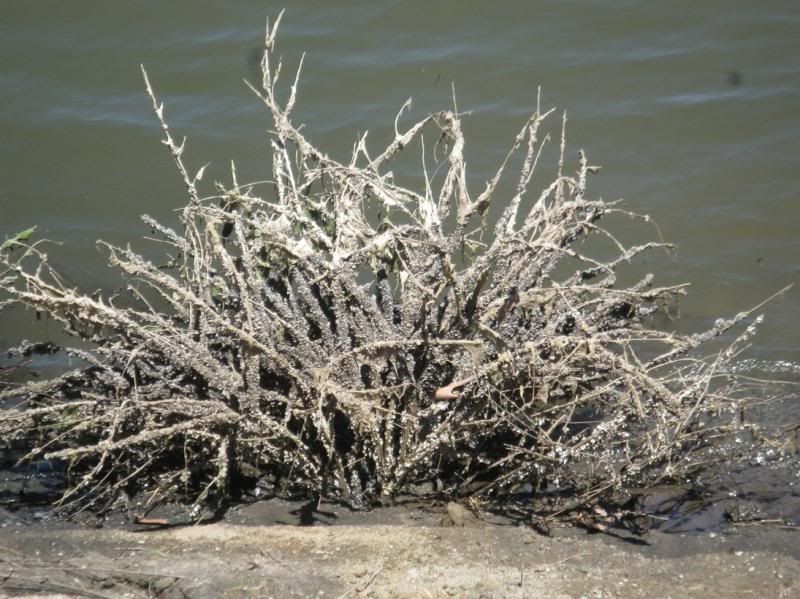
Originally Posted by
Tom

Here is a report I found on studies of the Colorado River
Summary of Laboratory Experiments to Evaluate Consumption of Juvenile/Adult Quagga Mussel by Redear Sunfish and Bluegill
Cathy Karp, Bureau of Reclamation, Fisheries and Wildlife Resources, Denver
Randy Thomas, Bureau of Reclamation, Boulder City
Establishment of zebra and quagga mussel in the United States has and will continue to have far-reaching negative economic and ecologic impacts (MacIssac 1996; Kennedy 2007; Strayer 2009; Western Regional Panel on Aquatic Nuisance Species 2009). Mussel infestations clog water intake and conveyance structures thereby reducing water delivery, pumping, and hydropower capabilities (Claudi and Mackie 1994; MacIssac 1996). Additionally, quagga and zebra mussels filter substantial amounts of water (Miller et al. 1992; Strayer 1999) which negatively alters the food web of infested waters, in part by increasing water clarity (MacIssac 1996; Snyder et al. 1997). They also generate and potentially concentrate toxic waste that may pass up the food chain. Possible dreissenid mussel control measures include chlorination (and other chemicals), oxygen deprivation, thermal, electrical, sonic and pressure shock, desiccation, antifouling coatings, toxic bacteria, and predation. The objective of this study was to determine if fish predation on quagga mussels could help suppress mussel colonization in the lower Colorado River. Redear sunfish, Lepomis micropholus, were selected for study because they are known molluscivores in southeastern United States (Lee et al. 1980), co-occur with quagga mussels in some areas (e.g., Lake Havasu, introduced to the Colorado River in mid-late 1940’s (Minckley 1973)), and have been found with quagga mussels in their stomachs ((Bureau of Reclamation, Zebra and Quagga Mussel Research Program, ZQMRP-2010-RN-06; Figure 1). Bluegills, L. macrochirus, were included because they co-occur with redear sunfish and quagga mussel in Lake Havasu.
Methods
Redear sunfish and bluegill were collected from the upper Lake Havasu, Colorado River in June 2009 and 2010 and transported to Reclamation’s Boulder City, Nevada Fish Lab. Fish were held in dechlorinated flowthrough water (19.4-25.6 oC (67-78 oF)) and fed earthworms once daily at least for one month prior to use in experiments. Water temperature was not controlled in first set of experiments and influenced by ambient air temperature. Unused fish were maintained on earthworms for use in later experiments. Fish were kept off feed for 24 h prior to an experiment. Quagga mussels (from the Colorado River and the Willow Beach National Fish Hatchery, US Fish and Wildlife Service) were brought into the lab 24 h prior to use in each set of experiments.
For each experiment, a group of 12-19 mussels were measured and counted into a 10 or 20 gallon aquaria so that each tank contained a similar size range and number of available mussels (small and large sized mussels were uncommon in late fall). After 24h during which the mussels had time to attach to the aquarium sides/bottom (dead mussels were removed and replaced with a similarly sized live individual before the start of each experiment), a single fish was added. Each tank was surrounded in black plastic so that there was no interference from neighboring tanks, or people. Additionally, artificial lighting was reduced during the day. Tanks were maintained on aerated flow-through water for 48 h. At the end of each experiment, the fish was removed from the tank, anesthetized (50-ppm Tricaine Methanesulfonate) and measured (fork length, FL, and total length, TL). Stomachs of some fish were examined for presence of whole or crushed mussels. Remaining mussels were counted and measured (length and height to the nearest mm) and mussel consumption was determined.
Stomachs of all potential molluscivore fish species occurring in lakes Havasu and Mohave were examined for presence of juvenile/adult quagga mussels.
Results
A total of 35 redear sunfish (N=28, 116-310 mm FL) and bluegill (N=7, 117-207 mm FL) predation experiments with quagga mussels were conducted in summer/fall 2009 and 2010. Most fish (85.7%) consumed quagga mussels (89.3% of redear sunfish and 71.4% of bluegill). Consumed quagga mussels averaged 12.4 mm length (3.0-26.8 mm) and 7.4 mm height (2.2-16.2 mm). The largest mussel offered was 28.3 mm in length and 16.1 mm height. Mean mussel size selected was highly correlated with fish size (r=0.7, P=0.0000; Figure 2). Ingested mussels were mostly crushed and shell pieces regurgitated by the redear sunfish. Conversely, ingested mussels were not crushed by bluegill.
A total of 110 fish stomachs comprising 10 species were examined (Table 1). Of these, four species, redear sunfish, bluegill, channel catfish, Ictalurus punctatus, and common carp, Cyprinus carpio, had consumed quagga mussels.
Discussion
Four fish species were found with quagga mussels in their digestive tract. Of these, redear sunfish is the only true molluscivore currently present in the lower Colorado River system. Redear sunfish have rounded molariform crushing teeth on both upper and lower pharyngeal arches that enables molluscivory when fish reach 25-75 mm in length (Huckins 1997; Huckins et al. 2000; Ledford and Kelly 2006; Collar and Wainwright 2009). Our study found that redear sunfish can consume quagga mussels up to 26.8 mm in length, and that size of predated mussel was correlated with predator size. Redear sunfish are also known to consume zebra mussels up to 20mm in length (French and Morgan 1995; Magoulick and Lewis 2002; Towns 2003).
Predation by crabs, crayfish, turtles, diving ducks, and over 20 fish species on zebra and to a much lesser degree quagga mussels has been documented (French 1993; Boles and Lipcius 1994; French and Morgan 1995; Tucker et al. 1996; Marsden 1997; Molloy et al. 1997; Thorp et al. 1998; Magoulick and Lewis 2002; Andraso 2005; Bartsch et al. 2005; Bowers and Szalay 2007; Watzin et al. 2008). Redear sunfish are not widespread in the lower Colorado River system as other mussel predators because they prefer vegetated littoral areas with submerged stumps and brush with very little or no flowing water (Pflieger 1975; Trautman 1981; Moyle 2002). However, redear sunfish may help to suppress quagga mussel colonization in areas where the two species co-occur.











 Reply With Quote
Reply With Quote



